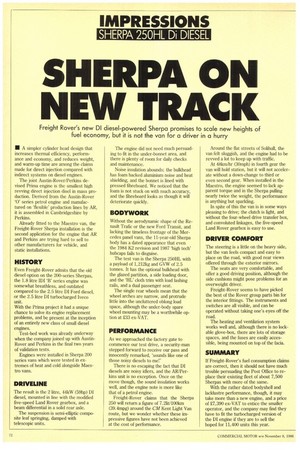SHERPA ON NEW TRACK
Page 74

If you've noticed an error in this article please click here to report it so we can fix it.
Freight Rover's new DI diesel-powered Sherpa promises to scale new heights of fuel economy, but it is not the van for a driver in a hurry
• A simpler cylinder head design that increases thermal efficiency, performance and economy, and reduces weight, and warm-up time are among the claims made for direct injection compared with indirect systems on diesel engines.
The joint Austin-Rover/Perkins devised Prima engine is the smallest high revving direct injection disel in mass production. Derived from the Austin-Rover '0' series petrol engine and manufactured on 'flexible' production lines by AR, it is assembled in Cambridgeshire by Perkins.
Already fitted to the Maestro van, the Freight-Rover Sherpa installation is the second application for the engine that AR and Perkins are trying hard to sell to other manufacturers for vehicle, and static installations_
HISTORY
Even Freight-Rover admits that the old diesel option on the 200-series Sherpas, the 1.8 litre IDI 13' series engine was somewhat breathless, and outdated compared to the 2.5 litre DI Ford diesel, or the 2.5 litre DI turbocharged Iveco unit.
With the Prima project it had a unique chance to solve its engine replacement problems, and be present at the inception of an entirely new class of small diesel engines.
Test-bed work was already underway when the company joined up with AustinRover and Perkins in the final two years of validation tests.
Engines were installed in Sherpa 200 series vans which were tested in extremes of heat and cold alongside Maestro vans.
DRIVEUNE
The result is the 2 litre, 44kW (59hp) DI diesel, mounted in line with the modified five-speed Land Rover gearbox, and a beam differential in a solid rear axle.
The suspension is semi-elliptic composite leaf springing, damped with telescopic units. The engine did not need much persuading to fit in the under-bonnet area, and there is plenty of room for daily checks and maintenance.
Noise insulation abounds; the bulkhead has foam backed aluminium noise and heat shielding, and the bonnet is lined with pressed fibreboard. We noticed that the foam is not stuck on with much accuracy, and the fibreboard looks as though it will deteriorate quickly.
BODYWORK
Without the aerodynamic shape of the Renault Trafic or the new Ford Transit, and lacking the timeless frontage of the Mercedes panel vans, the 11-year-old Sherpa body has a dated appearance that even the 1984 1(2 revision and 1987 'high tech' hubcaps fails to disguise.
The test van is the Sherpa 25OHL with a payload of 1,212kg and GVW of 2.5 tonnes. It has the optional bulkhead with the glazed partition, a side loading door, and the 'I-IL' cloth trim with load lashing rails, and a dual passenger seat.
The single rear wheels mean that the wheel arches are narrow, and protrude little into the uncluttered oblong load space, although the under-body spare wheel mounting may be a worthwhile option at £33 ex-VAT.
PERFORMANCE
As we approached the factory gate to commence our test drive, a security-man stepped forward to receive our pass and innocently remarked, 'sounds like one of those noisy diesels to me!'
There is no escaping the fact that DI diesels are noisy idlers, and the AR/Perkins unit is no exception. Once on the move though, the sound insulation works well, and the engine note is more like that of a petrol engine.
Freight-Rover claims that the Sherpa 250 will return a figure of 7.21k/100km (39.4mpg) around the CM Kent Light Van route, but we wonder whether these impressive figures have not been achieved at the cost of performance. Around the flat streets of Solihull, the van felt sluggish, and the engine had to be revved a lot to keep up with traffic.
At 48km/lir (30mph) in fourth gear the van will hold station, but it will not accelerate without a down-change to third or even second gear. When installed in the Maestro, the engine seemed to lack apparent torque and in the Sherpa pulling nearly twice the weight, the performance is anything but sparkling.
In spite of this the van is in some ways pleasing to drive; the clutch is light, and without the four-wheel drive transfer box, and convoluted linkages, the five-speed Land Rover gearbox is easy to use.
DRIVER COMFORT
The steering is a little on the heavy side, but the van feels compact and easy to place on the road, with good rear views offered through the exterior mirrors.
The seats are very comfortable, and offer a good driving position, although the side cushions might pose problems for an overweight driver.
Freight-Rover seems to have picked the best of the Rover group parts bin for the interior fittings. The instruments and switches are all visible, and can be operated without taking one's eyes off the road.
The heating and ventilation system works well and, although there is no lockable glove-box, there are lots of storage spaces, and the fuses are easily accessible, being mounted on top of the facia.
SUMMARY
If Freight-Rover's fuel consumption claims are correct, then it should not have much trouble persuading the Post Office to replace their existing fleet of about 7,500 Sherpas with more of the same.
With the rather dated bodyshell and lacklustre performance, though, it may take more than a new engine, and a price of £7,390 ex-VAT to entice the smaller operator, and the company may find they have to fit the turbocharged version of the DI engine if they are to sell the hoped for 11,400 units this year.




















































































































